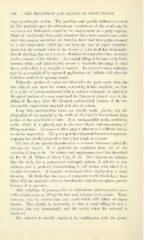Page 440 - My FlipBook
P. 440
438 THE TREATMENT AND FILLING OF ROOT CANALS.
ting an antiseptic action. The pecnliar and specific inflncnce exerted
by this niatenal npon the alhnminons constituents of the tooth may be
seen as a not infrequent sequel to its emph)ynient as a pidp capj)ing.
Many of sucli teeth whose pulp chambers have been opened some years
after the capjnng operation are found to have had their pulps changed
to a dry tough mass which has not been the seat of septic invasion
;
moreover, the normal color of the dentin of such teeth has been main-
tained, showing that no extensive chemical decomposition has occurred
in the contents of the tubules. As a canal filling it becomes very hard,
remains white, and when freshly mixed is markedly irritating to vital
tissue with which it is brought in contact. Its removal Avhen indicated
may be accomplished by repeated applications of sulfuric acid after the
Callahan method of opening canals.
When the meshes of cotton are filled with the paste made thin, the
zinc chlorid acts upon the cotton, converting it into amyloid ; so that
if a pellet of cotton moistened with a sedative antiseptic be placed in
the apical portion of a root canal and the thin paste placed over it, the
filling of the apex after the chemical action noted consists of the un-
changeable impervious amyloid and not of cotton.
Long thin gutta-percha cones are readily made plastic, but the
adaptation of the material to the walls of the canal is less intimate than
is that of the oxychlorid of zinc. It is unchangeable in the conditions
under which it is placed, and is the most bland and unirritating of
filling materials. Its removal after proper placement is difficult but by
no means impossible. The gutta-percha compound known as temporary
stopping has similar properties, but is less tough in texture.
The last of the plastics introduced is a resinous substance called the
bahamo del descrto. It is probably an exudation from one of the
varieties of pine or fir. Its virtues and employment were first described
by Dr. W. H. White of Silver City, N. M. His experiments indicate
that the resin has a ])ronounced antiseptic action ; it adheres to wet
surfaces, and is perfectly non-irritating to soft tissues with which it is
brought in contact. It remains unchanged when employed as a canal
dressing. He finds that the roots of temporary teeth which have been
filled with the material suffer no interference with the resorption process
because of its presence.
Thin solutions of gutta-percha in chloroform (chloro-percha) have
wide employment as fillings for fine and tortuous root canals. These
solutions may be carried into any canal which will admit the finest
broach. They shrink in hardening, so that a canal filling of such a
solution does not hermetically seal the cavity when the material is
hardened.
The solution is usually employed in combination with the gutta-


